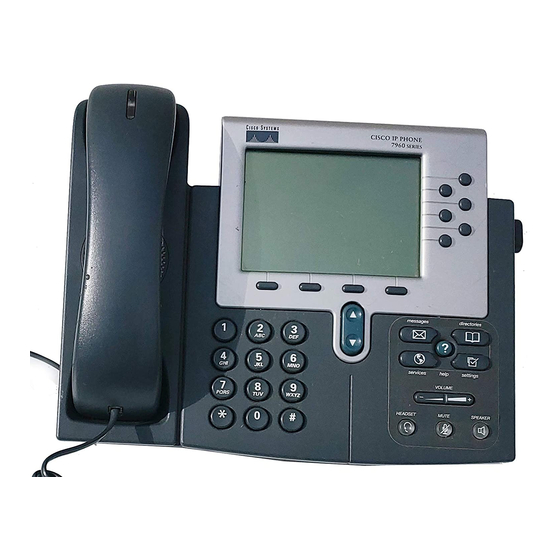Table of Contents
Advertisement
Quick Links
NetVanta Unified Communications Technical Note
___________________________________________________________________________________
Installing and Configuring Cisco 7940/7960
Series IP Phones
Introduction
The 7940/7960 IP Phone models from Cisco provide easy-to-use displays, modern styles, and broad
ranges of features. The 7940 offers two lines, while the 7960 offers six lines for increased productivity.
The 7940 and 7960 are interoperable with ADTRAN's NetVanta Enterprise Communications Server and
can be autodetected and configured with ease. The purpose of this technical note is to provide instructions
for installing and configuring Cisco phones with the NetVanta Enterprise Communications Server.
Known Integration Issues
There are no known integration issues at this time.
Enabling Cisco SIP Phone Configuration
This section describes how to install the Cisco configuration files and phone firmware so that Cisco 79x0
phones can be automatically detected and provisioned by the UC server.
Obtaining Firmware Upgrades
The UC server supports Cisco 79x0 session initiation protocol (SIP) firmware version P0S3-08-9-00.
ADTRAN does not distribute Cisco firmware, so you must obtain the firmware files from Cisco Systems
(http://www.cisco.com) or from your authorized Cisco reseller.
NOTE: You must have a maintenance contract with Cisco to access the firmware upgrades on Cisco's
corporate website.
The firmware files obtained from Cisco must be comprised of the following:
P0S3-08-9-00.loads
P0S3-08-9-00.sb2
P0S3-08-9-00.bin
P0S3-08-9-00.sbn
1
Advertisement
Table of Contents

Summary of Contents for Cisco IP Phones
- Page 1 Obtaining Firmware Upgrades The UC server supports Cisco 79x0 session initiation protocol (SIP) firmware version P0S3-08-9-00. ADTRAN does not distribute Cisco firmware, so you must obtain the firmware files from Cisco Systems (http://www.cisco.com) or from your authorized Cisco reseller. NOTE: You must have a maintenance contract with Cisco to access the firmware upgrades on Cisco’s corporate website.
- Page 2 (P0S3-08-9-00) (located in the same directory as this document) and copy it under the PhoneTypes folder located here: X:\Program Files\ADTRAN\NetVanta UC Server\Data\System\PhoneTypes, where X is the drive where the UC server program files are installed. For example, the resultant path after the folder is copied (henceforth known as the Cisco...
- Page 3 Enabling Support for Cisco SIP Phones To enable support for Cisco SIP phones: 1. Select Start > All Programs > NetVanta UC Server > Server Configuration Wizard. 2. Select the Phone Types step. 3. Select Next to bypass the welcome screen. 4.
- Page 4 Dynamic Host Configuration Protocol (DHCP) Server Configuration When a Cisco phone is plugged into the network, it retrieves an IP address from the DHCP server. It also checks one of the options for the IP address of the Trivial File Transfer Protocol (TFTP) provisioning server.
- Page 5 You must either have an unused identity that you can add to the phone, or you must create a new identity/user to associate with the phone. For more information about creating users and identities in the UC server, refer to the NetVanta UC Server Administrator Guide–Enterprise Communications Edition, available online at http://kb.adtran.com/.
- Page 6 Associating an Identity with the Phone After you install the phone and create a user/identity, you must associate that identity with the phone. To associate the identity with the phone: 1. Launch the UC client by selecting Start > All Programs > UC Client. 2.
-
Page 7: Troubleshooting
Ensure Windows Firewall is not blocking the TFTP port. Disable Windows Firewall. Create an exception for the NetVanta TFTP Service program: For example, C:\Program Files\ADTRAN\NetVanta UC Server\Bin\TFTPService.exe. Ensure the Cisco phone family is enabled. Run the Server Configuration Wizard and ensure that the Cisco phone family is checked. - Page 8 SIP<MAC>.cfg (where <MAC> is the MAC address of the phone being provisioned) If not present, redo the steps outlined in Enabling Cisco SIP Phone Configuration on page 1. Ensure that the NetVanta UC Server Application Services service has full permissions for the TFTP folder .\Program Files\ADTRAN\NetVanta UC Server\Data\TFTP.
- Page 9 3. The Cisco phone does not respond to restart/reload configuration requests from the UC client, or incorrect identity/identities assigned to the phone. If you experience the symptoms above, you can reset the protocol settings: Open a Telnet session to the phone. Enter the password cisco.







